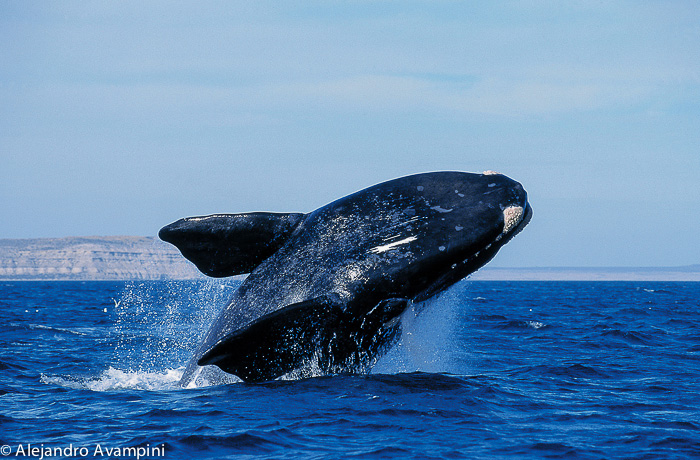 Argentine Patagonia, offers one of the best places in the world for whale watching. The morphology of this region of South America offers calm and protected waters, where this giant mammals has choosen to get birth to their calves and for mating (as other species also do), turning this World Heritage in a huge nursery. Most of the 300,000 visitors and tourists that reach the Valdes Peninsula each year arrive to Puerto Piramides to observe the Southern Right Whales.
Argentine Patagonia, offers one of the best places in the world for whale watching. The morphology of this region of South America offers calm and protected waters, where this giant mammals has choosen to get birth to their calves and for mating (as other species also do), turning this World Heritage in a huge nursery. Most of the 300,000 visitors and tourists that reach the Valdes Peninsula each year arrive to Puerto Piramides to observe the Southern Right Whales. 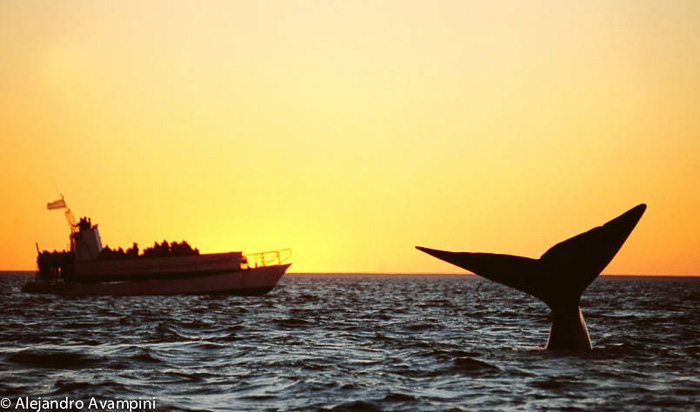 Like other whales, the southern right whale migrates twice each year: a trophic or feeding migration, to areas rich in zooplankton, near the Antarctic Convergence; and a reproductive migration towards coastal temperate waters, which provide a calm refuge from adverse weather conditions that they can suffer in the open sea and which would be risky for newborn calves. The Southern Right Whale, has ample space in the ocean where it spends its life. Those born in the Gulf Nuevo and Gulf San Jose not necessarily return every year to the Peninsula. They have welldefined areas for their fall and summer migrations and can travel thousands of miles on each trip.
Like other whales, the southern right whale migrates twice each year: a trophic or feeding migration, to areas rich in zooplankton, near the Antarctic Convergence; and a reproductive migration towards coastal temperate waters, which provide a calm refuge from adverse weather conditions that they can suffer in the open sea and which would be risky for newborn calves. The Southern Right Whale, has ample space in the ocean where it spends its life. Those born in the Gulf Nuevo and Gulf San Jose not necessarily return every year to the Peninsula. They have welldefined areas for their fall and summer migrations and can travel thousands of miles on each trip.  In fall, a time for breeding, they move northward as far as latitude 20 degrees. The furthest north where some very small groups of whales can be seen is on the coast of Brazil, in South America, and between Mozambique and the island of Madagascar in Africa. They are also found in Australia, New Zealand and South Africa.
In fall, a time for breeding, they move northward as far as latitude 20 degrees. The furthest north where some very small groups of whales can be seen is on the coast of Brazil, in South America, and between Mozambique and the island of Madagascar in Africa. They are also found in Australia, New Zealand and South Africa. 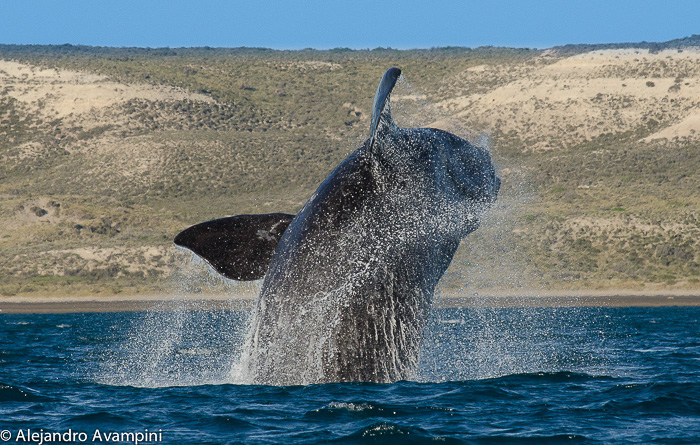 Arriving in December, they migrate back towards the feeding area around the 55th.the ICB (Whale Conservation Institute), it is estimated that in the winter-spring season, the whale population of Valdes Peninsula reachs over 2.000 individuals, the largest concentration of whales of this species in any breeding area, around the world. The calm waters of the gulf Nuevo and gulf San José , are very attractive to calves when learning to breathe, and are also favoured by whales at mating time.
Arriving in December, they migrate back towards the feeding area around the 55th.the ICB (Whale Conservation Institute), it is estimated that in the winter-spring season, the whale population of Valdes Peninsula reachs over 2.000 individuals, the largest concentration of whales of this species in any breeding area, around the world. The calm waters of the gulf Nuevo and gulf San José , are very attractive to calves when learning to breathe, and are also favoured by whales at mating time.
For the first time in history, during the 2014/2015 whale season, a complete migratory registry of the Southern Right Whale was made on an individual named “Papillon”. In this season, 2015 / 16, these small transmitters will be placed to 8 whales to know other routes. Although 5 different GPS satellite tracking devices had been placed on 5 different individuals, two of them stopped sending signals while in waters near the South Georgia Islands, believed to be one of the primary feeding grounds of this species. The other three spent their time feeding in waters near the continental shelf off the Patagonian coast of Argentina. The route marked in red on the map below is the itinerary completed by “Papillon” over an entire reproductive and feeding season.
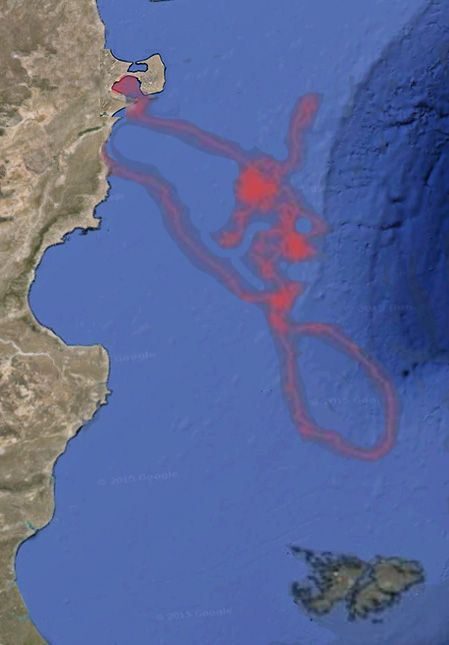
Guillermo Harris, president of the Patagonia Natural Foundation is the project manager. He keeps the community informed on progress in each whale season. He said that between 20 and 25 September 2015, again placed small transmitters to 8 right whales to add migratory routes. In a few days the transmitter of the first whale to be marked this year, called Primavera (Spring) began to track the map course to the feeding area. He sailed back and enjoy the waters of Valdes Peninsula in April or May next year, down here you can fine valuable information. The first number in the tag is the transmitter device and then there is the date and time of the location at the time of registration.  “Southern Right Whales of Argentina” is an educational documentary film by Chris and Genevieve Johnson.
“Southern Right Whales of Argentina” is an educational documentary film by Chris and Genevieve Johnson.
It explores the natural history and ecology of Southern Right Whales in Valdes Peninsula, Argentina, examining the complex relationship between humans and whales, and the effect of a changing marine environment of the southern hemisphere. “Southern Right Whales of Argentina” highlights international researchers working to understand and protect these whales and examines global conservation issues from a scientific perspective. The exponential increase and popularity of eco-tour activities in the region such as whale watching, provides hope for this endangered species on the edge. Argentina’s Atlantic Coast is a haven for southern right whales . The waters around Valdes Peninsula are breeding area of one of the largest populations that still exist in this species. “So begins this work that produced Earth Ocean, a little more than 20 minutes.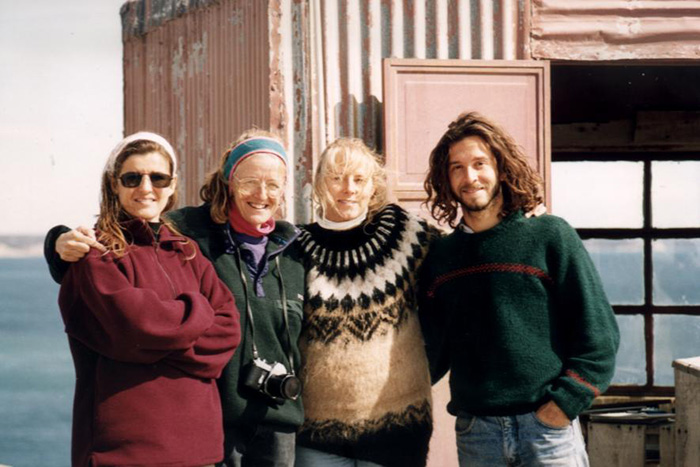 Centre interviews Dr . Mariano Sironi, scientific director of the Whale Conservation Institute, Vicky Rowntree, director of the Southern Right Whale program in Coservation Whale Institute. Both observe and record the behavior of whales, Dr. Jon Seger biology professor at the University of Utah in the United States. interview also Luciano Valenzuela, Researcher at ICB. Among explain general characteristics of this huge marine mammal show as performed whale photo-identification and harassment of gulls. Thanks to conservation efforts, the southern right whale is recovering steadily, after having reached the brink of extinction. You can also read the interesting synopsis that made Whale Trackers.
Centre interviews Dr . Mariano Sironi, scientific director of the Whale Conservation Institute, Vicky Rowntree, director of the Southern Right Whale program in Coservation Whale Institute. Both observe and record the behavior of whales, Dr. Jon Seger biology professor at the University of Utah in the United States. interview also Luciano Valenzuela, Researcher at ICB. Among explain general characteristics of this huge marine mammal show as performed whale photo-identification and harassment of gulls. Thanks to conservation efforts, the southern right whale is recovering steadily, after having reached the brink of extinction. You can also read the interesting synopsis that made Whale Trackers.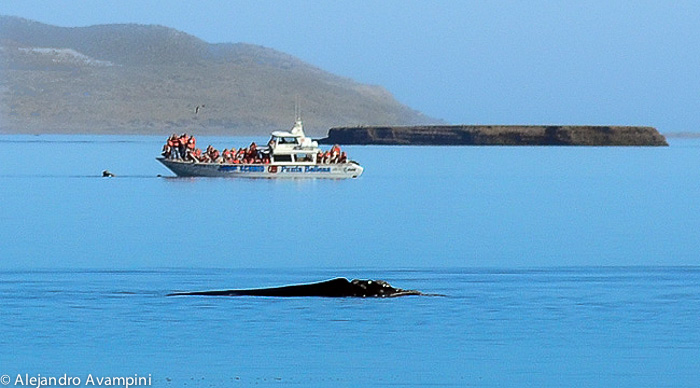 Thanks to humanities slow acquisition of environmental consciousness and after having nearly reached extinction, the Southern Right Whale is on the road to sustainable recovery. With this in mind, their future is still quite fragile and their long term survival is in our hands. The exponential increase and popularity of ecotourism in the region, such as whale watching, offers hope to this species in danger of extinction. Commercially on the rise since the 1970s, whale watching has created conflicts of interest amongst different countries, though little by little whales are ceasing to be pursued as an industrial resource and moving back into a place of respect, where they belong.
Thanks to humanities slow acquisition of environmental consciousness and after having nearly reached extinction, the Southern Right Whale is on the road to sustainable recovery. With this in mind, their future is still quite fragile and their long term survival is in our hands. The exponential increase and popularity of ecotourism in the region, such as whale watching, offers hope to this species in danger of extinction. Commercially on the rise since the 1970s, whale watching has created conflicts of interest amongst different countries, though little by little whales are ceasing to be pursued as an industrial resource and moving back into a place of respect, where they belong.
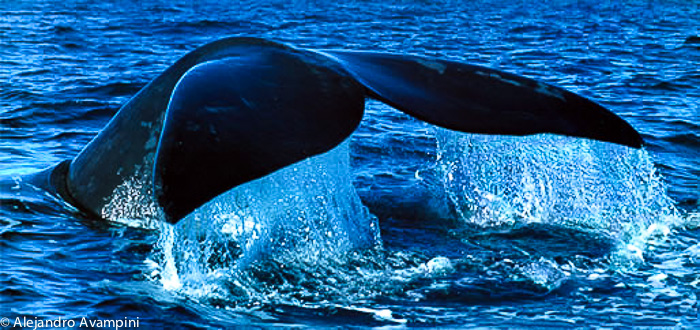 The shapes that the whales have, in general, are much different from most other living creatures. Even though their morphology is so different from our own, the anatomy of these monumental beings brings us close. A certain parentage with humans can be observed through the common characteristics that we share with the largest living being on our planet. Both are mammals, or better said, warm blooded vertebrates with hair and mammary glands. According to scientific discoveries we do share a common heritage, seen at the end of the Triassic, more than 200 million years ago. Understanding this significant family lasso allows us an important affinity with mammals, including marine mammals.
The shapes that the whales have, in general, are much different from most other living creatures. Even though their morphology is so different from our own, the anatomy of these monumental beings brings us close. A certain parentage with humans can be observed through the common characteristics that we share with the largest living being on our planet. Both are mammals, or better said, warm blooded vertebrates with hair and mammary glands. According to scientific discoveries we do share a common heritage, seen at the end of the Triassic, more than 200 million years ago. Understanding this significant family lasso allows us an important affinity with mammals, including marine mammals. 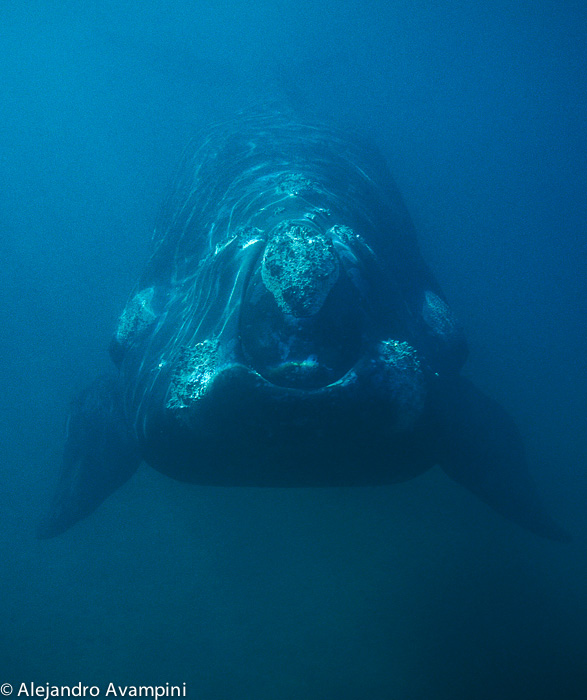
The dimensions of these marine mammals are incredible LENGTH Adult male: 14m Adult female: 15m Newborn: between 4 / 5 m. WEIGHT Adult male: 40tons Adult female: 45tons Newborn: between 2 and 3 tons 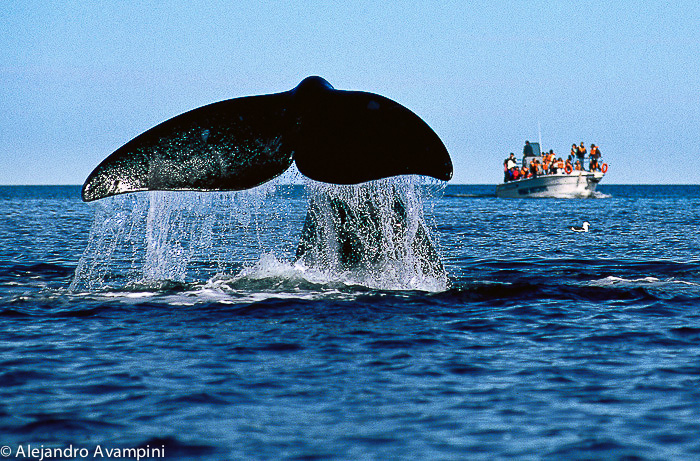 With nothing more than a comparison of the size of the whale’s head, which represents a third of its body, in relation to our own, which occupies barely an eighth, it is easy to see a tremendous difference between the species. I enjoy observing the life of the vast majority of marine animals, a world that rests horizontally in a cold, liquid medium, the head advancing forward with each movement of the tail.
With nothing more than a comparison of the size of the whale’s head, which represents a third of its body, in relation to our own, which occupies barely an eighth, it is easy to see a tremendous difference between the species. I enjoy observing the life of the vast majority of marine animals, a world that rests horizontally in a cold, liquid medium, the head advancing forward with each movement of the tail. 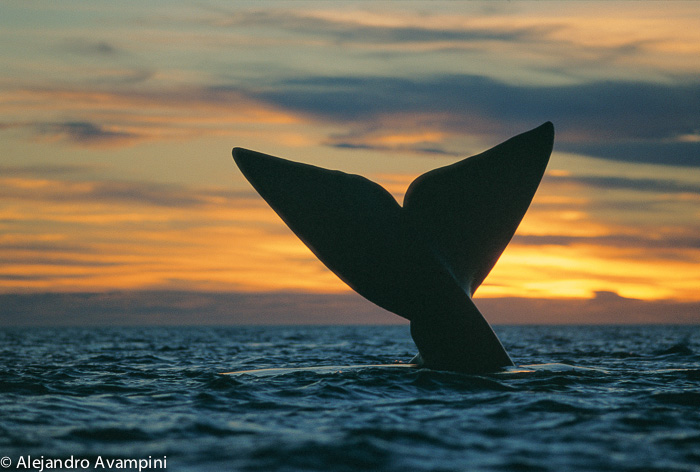 A smooth elastic skin, dark in color, wraps the entire body which, with calves, often appears lighter in shade than that of the adults. Most individuals have white underbelly markings and occasionally white markings on their backs or other areas of their body. Just below their constantly molting skin is stored a large layer of fat from 14 to 35cm thick, depending on which part of the body and the season.
A smooth elastic skin, dark in color, wraps the entire body which, with calves, often appears lighter in shade than that of the adults. Most individuals have white underbelly markings and occasionally white markings on their backs or other areas of their body. Just below their constantly molting skin is stored a large layer of fat from 14 to 35cm thick, depending on which part of the body and the season.
The Jump
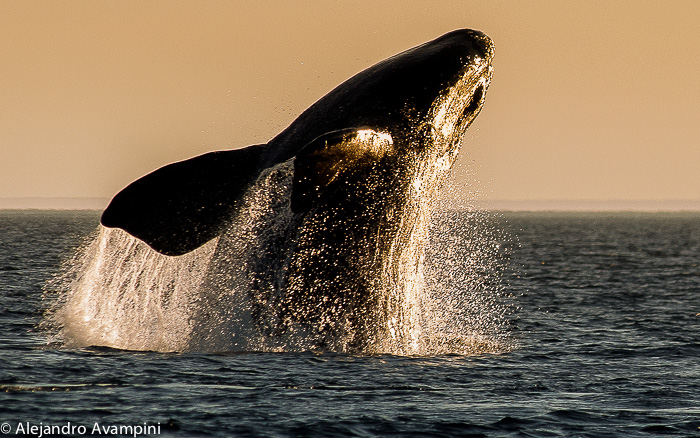 The southern right whale, like other whales, draws its body off the water in a unique and stunning show, which is commonly know as “breaching”. We are not entirely sure of the reasons behind the jump. Some scientists say the whale jumps because it is a way of communicating with other adult whales or calves. Others argue that another reason could be to try to see out of the water, perhaps just shapes and distances, but with eyes adapted to see salty underwater, it would be very unlikely to see the objects defined above, in the air and surface only at a glance. There are other possible reasons that cause the jump of the whale, one of them, which is tiny, is a small, crab-like creature,the cyamids, a crustacean parasite. There is evidence that there can be large concentrations of cyamids walking on the skin and callosities of the whale. Sometimes they can walk over very sensitive areas, such as the corner of the eye, and generate significant discomfort and it may be that, by breaching, the force generated by the animal falling back into the water, may dislodge some if not all of these parasites. Other annoyances that may generate breaching are the intense bites on their backs caused by seagulls, which lately developed the habit of feeding on their skin and fat. Whatever the reason for breaching, the sight of this amazing marine mammal propelling it’s body weight of more than 40 tons, 10 meters out of the water, using only the force of it’s tail or caudal fin, is a spectacle that is fantastic to behold.
The southern right whale, like other whales, draws its body off the water in a unique and stunning show, which is commonly know as “breaching”. We are not entirely sure of the reasons behind the jump. Some scientists say the whale jumps because it is a way of communicating with other adult whales or calves. Others argue that another reason could be to try to see out of the water, perhaps just shapes and distances, but with eyes adapted to see salty underwater, it would be very unlikely to see the objects defined above, in the air and surface only at a glance. There are other possible reasons that cause the jump of the whale, one of them, which is tiny, is a small, crab-like creature,the cyamids, a crustacean parasite. There is evidence that there can be large concentrations of cyamids walking on the skin and callosities of the whale. Sometimes they can walk over very sensitive areas, such as the corner of the eye, and generate significant discomfort and it may be that, by breaching, the force generated by the animal falling back into the water, may dislodge some if not all of these parasites. Other annoyances that may generate breaching are the intense bites on their backs caused by seagulls, which lately developed the habit of feeding on their skin and fat. Whatever the reason for breaching, the sight of this amazing marine mammal propelling it’s body weight of more than 40 tons, 10 meters out of the water, using only the force of it’s tail or caudal fin, is a spectacle that is fantastic to behold.
Calluses
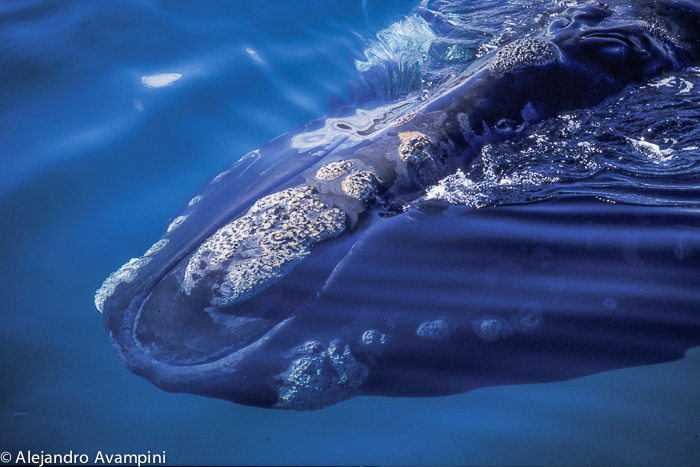 These calluses with hard and light forms have a rough base and sometimes take the form of small leaves. They are about 5 cm in height, are formed in the foetal stage and grow with the animal, throughout his life. They are found along the upper margin of the lower lip, jaw, dorsal surface of the face and eyes, forming a kind of eyebrow. In all specimens of right whales, the largest one is the bonnet which is on the end of the snout of the animal. These dark gray calluses have populations of cyamids, commonly known as whale-lice. The calluses sometimes host colonies of barnacles which can cause them to take on a yellow or orange colour.
These calluses with hard and light forms have a rough base and sometimes take the form of small leaves. They are about 5 cm in height, are formed in the foetal stage and grow with the animal, throughout his life. They are found along the upper margin of the lower lip, jaw, dorsal surface of the face and eyes, forming a kind of eyebrow. In all specimens of right whales, the largest one is the bonnet which is on the end of the snout of the animal. These dark gray calluses have populations of cyamids, commonly known as whale-lice. The calluses sometimes host colonies of barnacles which can cause them to take on a yellow or orange colour.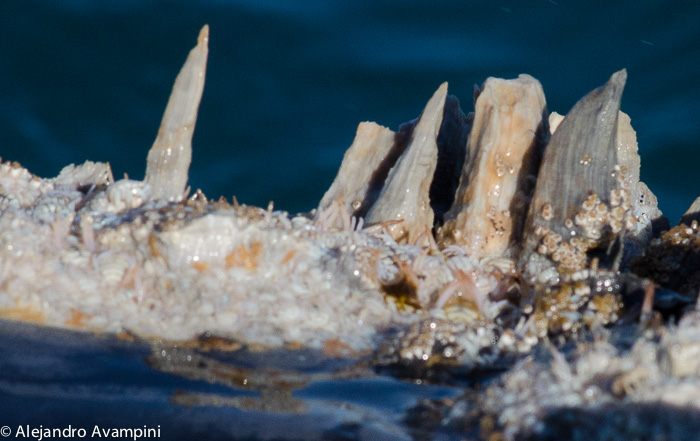 While all the whales have these skin blemishes, not all are in the same place or the same way. Each whale has its own unique distribution of calluses. 40 years ago, Roger Paine decided to use this unique distribution to enable photo- identification of whales.
While all the whales have these skin blemishes, not all are in the same place or the same way. Each whale has its own unique distribution of calluses. 40 years ago, Roger Paine decided to use this unique distribution to enable photo- identification of whales.  This was the first major discovery that Roger Paine offered in the study of this animal. These callosities harbor populations of small crustaceans called cyamids, commonly referred to as whale lice and very often interlaced with cirripedia (barnacles) causing an orange or yellow hue to the callosities.
This was the first major discovery that Roger Paine offered in the study of this animal. These callosities harbor populations of small crustaceans called cyamids, commonly referred to as whale lice and very often interlaced with cirripedia (barnacles) causing an orange or yellow hue to the callosities.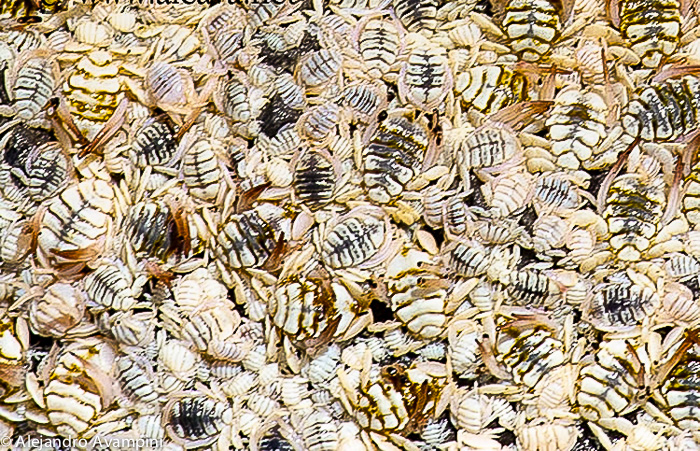
According to the results of a very interesting and deductive study realized by Vicky Rowntree, on cyamids, this parasite/host relationship has gone on for more than 6 million years. Although these external parasites are inoffensive, though possibly bothersome, their DNA carries more information about the whales than the whales themselves.
 In 1970 Roger Paine, here in Valdes Peninsula, discovered that he could be individually identified by photographs of the whales from the head´s calluses patterns. That was the beginning of the program of Southern Right Whale Research. Currently, this program is the study of longer duration in the world based on whale photo-identification. Until then, what was known about whales came mostly from the analysis of specimens hunted by the whaling industry.
In 1970 Roger Paine, here in Valdes Peninsula, discovered that he could be individually identified by photographs of the whales from the head´s calluses patterns. That was the beginning of the program of Southern Right Whale Research. Currently, this program is the study of longer duration in the world based on whale photo-identification. Until then, what was known about whales came mostly from the analysis of specimens hunted by the whaling industry.
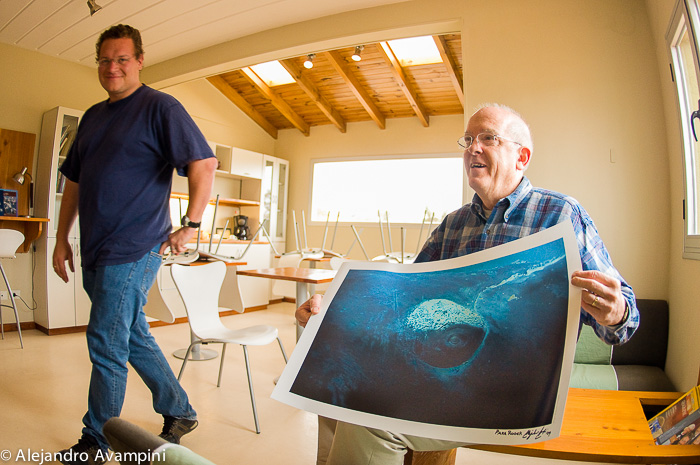
I give him the picture “SOS tu destino” beacause this picture shocked years ago Roger Paine who believes that “It is the best photo of a whale’s eyes have ever seen” … and the proud photographer, can only boast of such a compliment!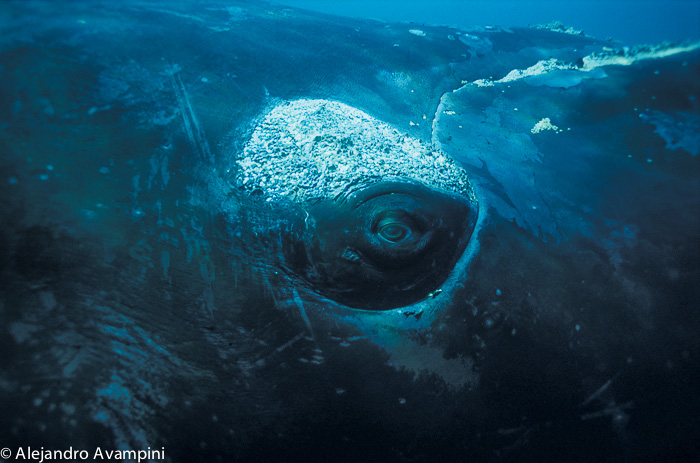 His work has been featured over thirty documentaries for television, including the documentary made in 1991, which was nominated for Emmy Awards “In the company of whales”. In 1995, Dr. Payne co-wrote and co-directed a production of IMAX, “Whales”, which was very popular among the critics and the general public.An estimated audience of 40,000 people across the world sees that footage weekly. Dr. Payne always wanted to films and publications how can help, educate and raise awareness about the uncertain future of the planet
His work has been featured over thirty documentaries for television, including the documentary made in 1991, which was nominated for Emmy Awards “In the company of whales”. In 1995, Dr. Payne co-wrote and co-directed a production of IMAX, “Whales”, which was very popular among the critics and the general public.An estimated audience of 40,000 people across the world sees that footage weekly. Dr. Payne always wanted to films and publications how can help, educate and raise awareness about the uncertain future of the planet
Dr. Payne discovered that following the lives of individuals, could learn much more about the whales of what was known from dead animals, as they can make population census, and specific information on various aspects of their behavior throughout their lives. This research carries on today in Valdes Peninsula, the Whale Conservation Institute (ICB). Just above each eye there is a callosity that is referred to as the eyebrow. At the extreme end of the whale’s “snout” is the largest of the callosities known as the bonnet. Along the upper jaw the callosities tend to be less continuous with this species, when compared to its counterpart, the Northern Right Whale. Frequently callosities will be present along the upper edge of the lower “lips”. Their eyes are incredibly expressive and in my experience diving with them one can experience an unforgettable level of communication, through visual contact, full of simplicity and wisdom. 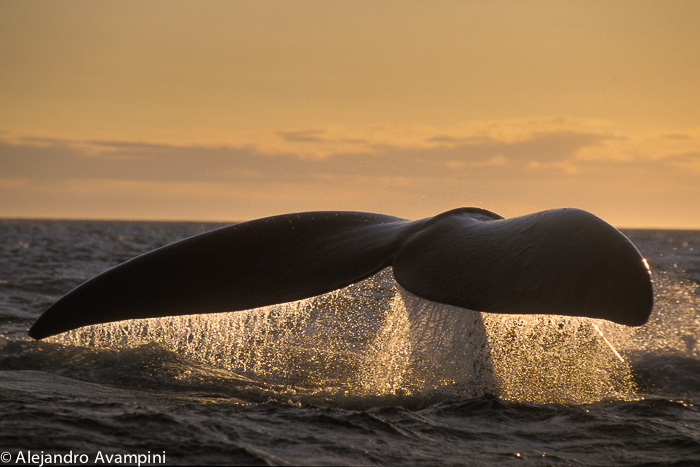
Feeding
The diet consists mainly of krill. They also eat larvae of various invertebrates, fish larvae and sea- floor organisms. While for many years it was believed that breeding whales fasted, today, thanks to the observations made by the captains of whale- watching boats and by analyzing stool samples, it has been found that while in the Gulfs of Valdes Peninsula, whales feed on zooplankton (lobster larvae, copepods and krill species present in the area) as well as sea floor organisms. The maximum depth recorded for this species is 184 mts. Maximum apnoea recorded 50 minutes at feeding areas (in the mating area dives rarely exceed 10 minutes). Unlike the dolphins which are toothed whales (have teeth) whales belong to the suborder of baleen whales, comprising few large species, the largest of which is the Blue Whale which can measure more than 30 meters long. The whales differ from other cetaceans in several ways, but the most obvious difference is that they have no teeth but baleens plates. Baleen is a flexible material called keratin (the same material of our nails and hair), with the outer edge smooth, and the inner in frayed fibers like a horse’s mane. The baleen plates hang from the upper jaw and are excellent for filtering food out of seawater. The southern right whale has between 220 and 260 baleen spread on both sides of the upper jaw. The central ones can measure up to 1.80 meters long. 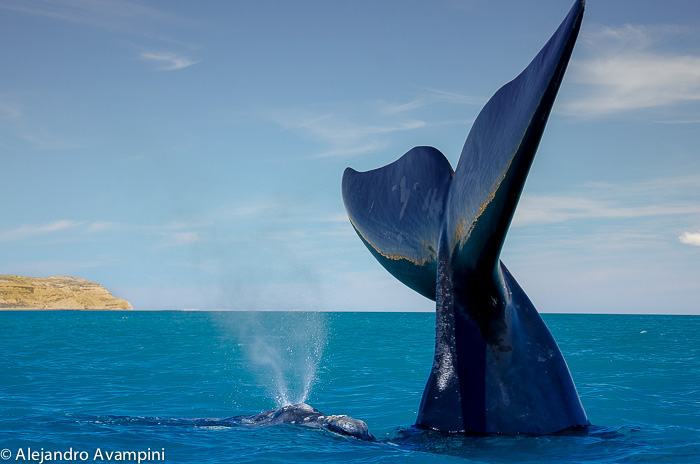
Reproduction
The southern right whale females reach sexual maturity at five or six years old. The mating or courtship takes place with several males and a female courted is enclosed by the sides by 2, 3 or more males. Mating can last more than one day, and the female, to avoid being coupled is placed belly up, position which she can only hold for a few minutes, because of the need to breathe. A tactic developed by males is to support the belly on the back of the female, while others keep their positions on the sides. When the female turns to breathe, males are pushed until one of them manages to copulate.
Other times, as observed from whale watching boats in Puerto Piramides, while the female is belly up, males look for the vaginal slit with their penises.The male penis is about 2 meters long and its owner has control all of the movements, in much the same way that an elephant has control of it’s trunk. If the male is able to penetrate the female by a few centimetres, it can exert a force powerful enough to turn the female to him, and to facilitate intercourse. Copulation lasts no more than 30 seconds but courtship activity can be extended for several hours and generally almost all males copulate, but only one fertilizes the female. According to research provided by Patagonia Natural Foundation, the rate of reproduction is a calf every three years. The gestation period is 12 months, followed by a further 12 months of suckling the calf and another 12 months gestation.The wahles do not have multiple births, producing only one calf with each pregnancy. Births occur mainly between August and late October. Whale milk is oily and has a viscous consistency because it has more than 50% fat and 12% of proteins, allowing the calf grow between 2 and 3 cm daily, twice its size at the end of feeding, after a year. 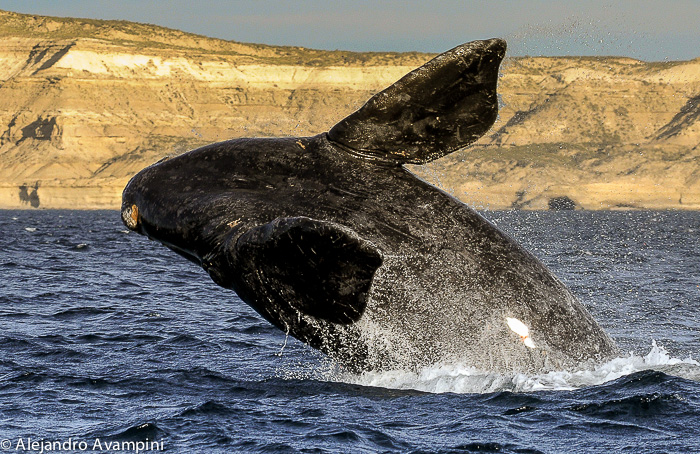 One mating technique used by the males is for a male to move on top of the female while other males hold their positions on either side. When the female turns, in an attempt to breath, the males advance on her until one is able to mate. Other times, observing from whale watching boats in Puerto Piramide, we will see how the males will literally probe with their penis, looking for the vagina while she lays belly up on the surface.
One mating technique used by the males is for a male to move on top of the female while other males hold their positions on either side. When the female turns, in an attempt to breath, the males advance on her until one is able to mate. Other times, observing from whale watching boats in Puerto Piramide, we will see how the males will literally probe with their penis, looking for the vagina while she lays belly up on the surface.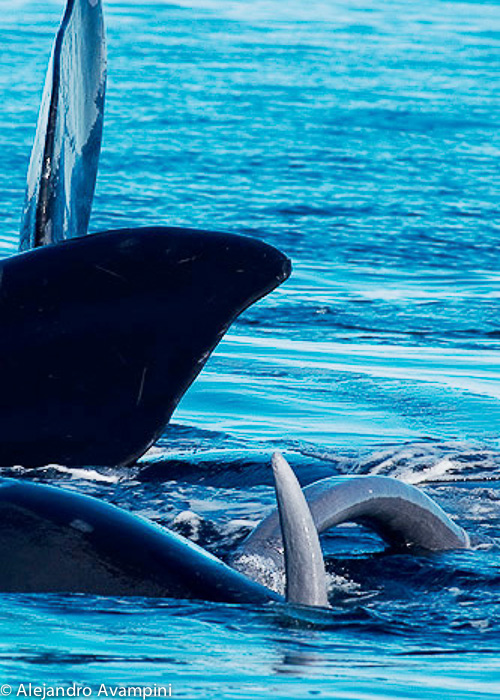
It is worth noting that the male’s reproductive organ is in the neighborhood of two meters in length and with absolute control of its mobility, much like that of an elephant’s trunk. The male being able to penetrate just a few centimeters is able to apply enough force to turn the female over, while floating on the surface, bringer her closer and facilitating coitus. The act itself will last no more than 30 seconds, but courting can go on for several hours or more and, in general, most all of the males will mate, with only one of them fertilizing the female. 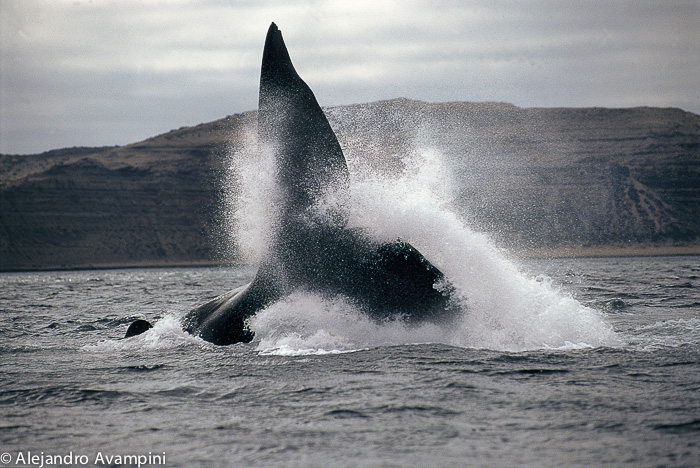 The fluke or tail fin of the Southern Right Whale is one the strongest forces in the animal kingdom, easily demonstrated with each breach the whales make, carrying ¾ of their more than 40 thousand kg bodies out of the water. The fluke is made up of fibrous tissues that connect to the body by the caudal peduncle, conformed of very powerful muscles. The fluke of an adult individual can stretch a breadth of as much as five meters.
The fluke or tail fin of the Southern Right Whale is one the strongest forces in the animal kingdom, easily demonstrated with each breach the whales make, carrying ¾ of their more than 40 thousand kg bodies out of the water. The fluke is made up of fibrous tissues that connect to the body by the caudal peduncle, conformed of very powerful muscles. The fluke of an adult individual can stretch a breadth of as much as five meters. They can be observed holding this position for hours, coming up to breath every few minutes and then returning to take the previous position once again. Scientists argue that this behavior could be related to thermoregulation or as a pre-birthing exercise. Mothers, before giving birth, are observed raising huge volumes of their fluke and peduncle out of the water.
They can be observed holding this position for hours, coming up to breath every few minutes and then returning to take the previous position once again. Scientists argue that this behavior could be related to thermoregulation or as a pre-birthing exercise. Mothers, before giving birth, are observed raising huge volumes of their fluke and peduncle out of the water.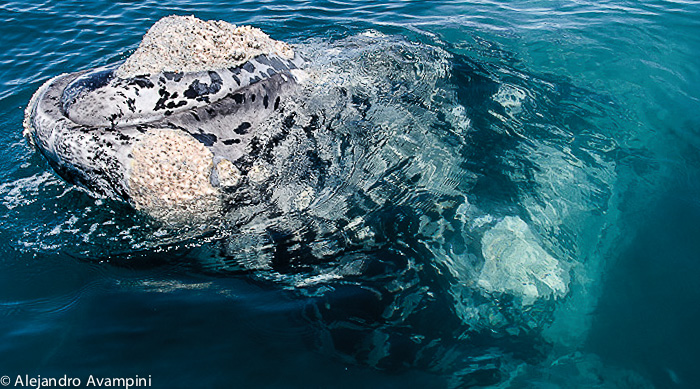 The white whale it’s a nature’s rareness. Just like in others species, there are some whales born with their skin white instead of black because of the lack of pigmentation. It’s not very common to see them during a whale watching in Puerto Pirámides, but it is probably that a couple of this peculiar white whales born every year. Their behavior it’s just the same as any other whale: they jump, feed of its mother and show us their tail! The difference between this albinism and another animal’s albinism, it’s that in whales tends to disappear in their first years of life. While the years go by, their skin begins to get darker, going from white to grey, and finally black. As you can see in the top image, this white whale is son of a young white female whale who hasn’t get her skin dark yet. If you see one of these whales underwater, they seem to be green, because of the water’s transparency.
The white whale it’s a nature’s rareness. Just like in others species, there are some whales born with their skin white instead of black because of the lack of pigmentation. It’s not very common to see them during a whale watching in Puerto Pirámides, but it is probably that a couple of this peculiar white whales born every year. Their behavior it’s just the same as any other whale: they jump, feed of its mother and show us their tail! The difference between this albinism and another animal’s albinism, it’s that in whales tends to disappear in their first years of life. While the years go by, their skin begins to get darker, going from white to grey, and finally black. As you can see in the top image, this white whale is son of a young white female whale who hasn’t get her skin dark yet. If you see one of these whales underwater, they seem to be green, because of the water’s transparency.
A little bit of history about Man and the Whale:
The Southern Right Whale is a warm blooded living being that has suffered man’s industrialization of the world’s natural resources. Over hundreds of years Man hunted and killed whales, sea lions and seals amongst many other species with the goal of using their fat, reduced to oil, for making candles and thus lighting the streets and homes of Europe and the colonized continents. Various parts of the whale’s remains were also used in the making of frivolous cosmetic products. Their baleen filters, used by the right whales and all other mysticeti for feeding, were processed to make umbrellas, corsets and other massively consumed products.  It is estimated that the numbers of Southern Right Whale before the indiscriminant commercial hunting of these animals reached well over 50,000 individuals. With the discovery of petroleum, gas and electricity, these enormous marine mammals have, little by little, lost their importance in the industrial world. Many species were unable to survive the voracious consumer market. One such is the North Atlantic Right Whale, a species that occupied the Bay of Biscay in northern Spain and was similar to the Southern Right Whale.
It is estimated that the numbers of Southern Right Whale before the indiscriminant commercial hunting of these animals reached well over 50,000 individuals. With the discovery of petroleum, gas and electricity, these enormous marine mammals have, little by little, lost their importance in the industrial world. Many species were unable to survive the voracious consumer market. One such is the North Atlantic Right Whale, a species that occupied the Bay of Biscay in northern Spain and was similar to the Southern Right Whale. 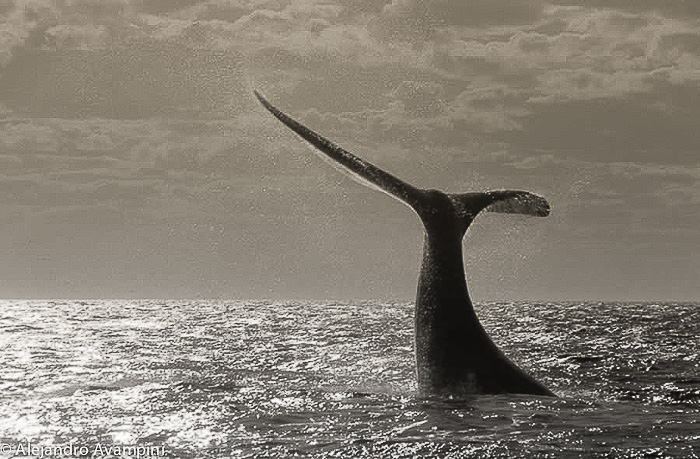 In 1937, when only several hundred individuals remained, the Southern Right Whale was provided total protection with the signing of the International Agreement for the Regulation of Whaling. From this point forward the recovery of the Southern Right Whale has been slow but sustainable. In 1984 this species was declared by the Argentine Republic as a National Natural Monument. Thanks to a change in vision and consciousness that the age of Aquarius as awakened, today the Southern Right Whale is observed by thousands of tourists in Valdes Peninsula aboard whale watching boats or from the coast, perceiving through new eyes the wonder of diversity that our small and fragile planet offers. It is a much more positive memory enjoying a photograph taken of the whales instead of a keratin umbrella made from baleen filters, just in case it rains! An amazing underwater video of the whales was uploaded to You Tube by the well known documentary cameraman, Luis Burgueno. The clip is published here and thanks to a variety of angles and the clarity of the water, these giant and adorable marine mammals can be viewed at home in the waters of the Valdes Peninsula.
In 1937, when only several hundred individuals remained, the Southern Right Whale was provided total protection with the signing of the International Agreement for the Regulation of Whaling. From this point forward the recovery of the Southern Right Whale has been slow but sustainable. In 1984 this species was declared by the Argentine Republic as a National Natural Monument. Thanks to a change in vision and consciousness that the age of Aquarius as awakened, today the Southern Right Whale is observed by thousands of tourists in Valdes Peninsula aboard whale watching boats or from the coast, perceiving through new eyes the wonder of diversity that our small and fragile planet offers. It is a much more positive memory enjoying a photograph taken of the whales instead of a keratin umbrella made from baleen filters, just in case it rains! An amazing underwater video of the whales was uploaded to You Tube by the well known documentary cameraman, Luis Burgueno. The clip is published here and thanks to a variety of angles and the clarity of the water, these giant and adorable marine mammals can be viewed at home in the waters of the Valdes Peninsula.




